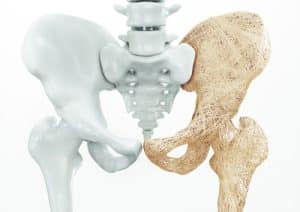Osteoporosis: Symptoms, Risk Factors, Prevention
September 10, 2019

But as we grow older, bone loss may outpace the growth of new bone. Osteoporosis literally means “porous bone,” and it is a disease that causes the density and quality of bone to be reduced. As bones become more porous and fragile, the risk of fracture increases.
Osteoporosis symptoms & risk factors
There typically are no symptoms in the early stages of bone loss. Once your bones are weakened by osteoporosis, you might have signs and symptoms such as back pain caused by a fractured or collapsed vertebra; loss of height over time; stooped posture; or a bone that breaks much more easily than expected. The most common fractures associated with osteoporosis occur at the hip, spine, and wrist. The likelihood of these fractures occurring, particularly at the hip and spine, increases with age in both women and men.
Several factors can increase the likelihood of developing osteoporosis, including your age, race, lifestyle choices, and medical conditions and treatments. Some of these are unchangeable and out of your control.
- Your sex & sex hormones. Women are much more likely to develop osteoporosis than men. Lowered sex hormone levels tend to weaken bone, and the reduction of estrogen levels in women at menopause is one of the strongest risk factors for developing osteoporosis.
- Age. The older you get, the greater your risk of osteoporosis. This is true for men and women.
- Race. You’re at greatest risk of osteoporosis if you’re white or of Asian descent.
- Family history. Having a parent or sibling with osteoporosis puts you at greater risk.
- Body frame size. Men and women who have small body frames tend to have a higher risk because they might have less bone mass to draw from as they age.
- Low calcium intake. A lifelong lack of calcium plays a role in the development of osteoporosis. Low calcium intake contributes to diminished bone density, early bone loss, and an increased risk of fractures.
- Steroids & other medications. Long-term use of oral or injected corticosteroid medications, such as prednisone and cortisone, interferes with the bone-rebuilding process.
- Other medical problems. The risk of osteoporosis is higher in people who have certain medical problems, such as celiac disease; inflammatory bowel disease; kidney or liver disease; cancer; lupus, multiple myeloma; and rheumatoid arthritis.
While the above factors may be out of your control or the damage may already be done, there are some lifestyle choices that can also increase your risk of developing osteoporosis. This includes:
- Sedentary lifestyle. People who spend a lot of time sitting have a higher risk of osteoporosis than do those who are more active.
- Excessive alcohol consumption. Regular consumption of more than two alcoholic drinks a day increases your risk of osteoporosis.
- Tobacco use. The exact role tobacco plays in osteoporosis isn’t clear, but it has been shown that tobacco use contributes to weak bones.
- Eating disorders. For those who have severely restricted food intake and are underweight, bones may be weaker in both men and women.
Prevention, diagnosis and treatment
It is possible to take steps to prevent and treat osteoporosis. It’s now a largely treatable condition with a combination of lifestyle changes and appropriate medical treatment.
Calcium. Calcium is thought to be particularly important. Men and women between the ages of 18 and 50 need 1,000 milligrams of calcium a day. This daily amount increases to 1,200 milligrams when women turn 50 and men turn 70. If you don’t think you get enough calcium from your diet, you may want to consider taking calcium supplements. However, too much calcium has been linked to kidney stones, and some experts suggest that too much calcium, especially in supplements, can increase the risk of heart disease. Always consult your doctor about this.
Good sources of calcium include:
- Low-fat dairy products
- Dark green leafy vegetables
- Canned salmon or sardines with bones
- Soy products, such as tofu
- Calcium-fortified cereals and orange juice
Body weight. Being underweight increases the chance of bone loss and fractures. Excess weight is now known to increase the risk of fractures in your arm and wrist. The bottom line is that maintaining an appropriate body weight is good for bones and overall health.
Vitamin D. Vitamin D improves your body’s ability to absorb calcium and improves bone health in other ways. We can get some of our vitamin D from sunlight, but supplements may be necessary for various reasons.
Exercise. Exercise can help you build strong bones and slow bone loss. Exercise will benefit your bones no matter when you start, but you’ll gain the most benefits if you start exercising regularly when you’re young and continue to exercise throughout your life.
While osteoporosis itself isn’t painful, it does lead to fractures and other painful problems, usually becoming more severe with age. But this is not an inevitable part of growing older. There are a variety of treatment options we can explore to help you find relief. Let your doctor at Southside Pain Specialists know if you think you may be exhibiting signs of osteoporosis, and we will help find ways to manage it.
Southside Pain Specialists is your one-stop shop for pain management
With a multitude of pain relief options tailored to your specific needs, Southside Pain Specialists follow the standards of the American Society of Interventional Pain Physicians, The American Board of Pain Medicine and the International Spinal Injection Society and works hard to provide patients comprehensive, caring pain relief when they need it most. Check out our website or contact us today at 205.332.3155 to learn more.
